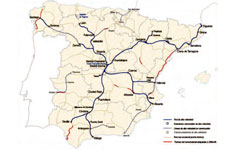
Categories
Publications
Long Term Implications of HSR on Small cities: Ciudad Real and Puertollano revisited 25 years after the arrival of the HSR
3/7/2018

Up to 10-15 years after the arrival of the HSR to two small and isolated Spanish cities a considerable amount of studies about the territorial and urban impacts/implications of HSR were done based on the cities of Ciudad Real and Puertollano. Their distance to major cities (at least 200 km to any cities of more than 100.000 inhabitants) made it easy to try to isolate the impacts/implications due to HSR from those derived from other reasons.
The paper does the same analyses that were undertaken 15-10 years ago, to evaluate those implications/ impacts that have been consolidated on a greater long-term perspective and those which have changed and/or disappeared (less permanent more variable).
These two cities are compared to other similar ones, as it was done in Serrano, R, Garmendia, M, Coronado, J.M, Pillet, F. y Ureña, J.M. (2006) Análisis de las consecuencias territoriales del ave en ciudades pequeñas: Ciudad Real y Puertollano, Estudios Geográficos, vol. LXVII, n. 260, pp. 199-229. (ISSN-0014-1496) and even previously in Fariña, J, Lamiquiz, F y Pozueta, J. (2000) Efectos Territoriales de la implantación de infraestructura de accesos controlados, Madrid, E.T.S. Arquitectura, Universidad Politécnica de Madrid, Cuadernos de Investigación Urbanística, n. 29.
The policies/strategies implemented in these two cities are also revisited, as it was done in Ribalaygua, C., Ureña, J.M., Coronado, J.M., Escobedo, F., Guirao, B., Menéndez, J.M., Rivas, A. y Rodríguez, F.J. (2004) “Alta Velocidad, integración metropolitana y proyectos territoriales. El caso de Ciudad Real y Puertollano”, URBAN, n. 9, pp. 30-44.
The two conclusions derived from revisiting these analyses undertaken 10-15 years ago in these two HSR cities show that:
The change in growth tendencies produced shortly after the HSR arrival:
- a positive change in the tertiary city of Ciudad Real between 10 and 20 years after the arrival of HSR, that tends to be maintained after these first 20 years, with a slight diminution tendency.
- a negative change in the industrial city of Puertollano until 10 years after the arrival of HSR that tends to be maintained between 10 and 20 years and worsens between 20 and 25 years
The projects/strategies being developed 10-15 years after the HSR arrival can be classified in the long term into three groups:
- those that tried to change the territorial model in general are having big difficulties,
- those that adapt the station urban surroundings in general are being more successful -the success of those that tried to attract new activities in general is greatly influenced by the type of city (industrial vs tertiary) and the national overall economic dynamism (economic cycle).
Download paper »


